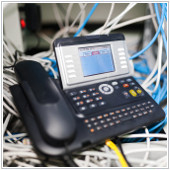Not that long ago, VoIP services were a new and revolutionary concept. Nowadays, internet-based voice communication is commonplace among SMBs, which means it’s time to turn our attention toward improving their security. Without a thorough understanding of what is needed to protect your VoIP systems, you could be vulnerable to cyberattacks. Let’s take a closer […]
 Not that long ago, VoIP services were a new and revolutionary concept. Nowadays, internet-based voice communication is commonplace among SMBs, which means it’s time to turn our attention toward improving their security. Without a thorough understanding of what is needed to protect your VoIP systems, you could be vulnerable to cyberattacks. Let’s take a closer look at 5 important tips for protecting your web-based communication devices and services.
Not that long ago, VoIP services were a new and revolutionary concept. Nowadays, internet-based voice communication is commonplace among SMBs, which means it’s time to turn our attention toward improving their security. Without a thorough understanding of what is needed to protect your VoIP systems, you could be vulnerable to cyberattacks. Let’s take a closer look at 5 important tips for protecting your web-based communication devices and services.
Types of threats
The majority of VoIP services involve live communications, which often seem far more innocuous than stored data. Unfortunately, your business has just as much valuable information moving across VoIP networks as it does hosted on company servers. Internet-based calls are far more vulnerable to fraud compared to more traditional telephony services and face threats from identity theft, eavesdropping, intentional disruption of service and even financial loss.24/7 monitoring
A recent study by Nettitude reported that 88 percent of VoIP security breaches take place outside of normal operating hours. This could be attackers trying to make phone calls using your account or gain access to call records that contain confidential information. This can be avoided by contracting outsourced IT vendors to monitor network traffic for any abnormalities or spikes in suspicious activity.VoIP firewalls
Every VoIP vendor should provide a firewall specially designed for IP-based telephony. These protocols will curb the types of traffic that are allowed, ensure the connection is properly terminated at the end of a session and identify suspicious calling patterns. Consult with your VoIP or IT services provider about which of these features are available and currently in use at your organization.Encryption tools
One of the reasons that eavesdropping is so common is because a lack of encryption. Inexperienced attackers can easily download and deploy tools to intercept and listen to your calls. Although some services claim built-in encryption, be sure to investigate how effective they really are. Many of these protocols require the same VoIP client on the receiving end of the call -- something that’s much harder to control. Encryption should be compatible with as many other software clients as possible to effectively prevent anyone from undermining the privacy of your calls.Virtual private network
Virtual private networks (VPNs) create a secure connection between two points as if they were both occupying the same, closed network. It’s like building a tunnel between you and the call receiver. In addition to adding another layer of encryption, establishing a VPN can also overcome complications involving Session Initiation Protocol trunking, a recommended VoIP feature.Password protection
Usually password protection refers to requiring password authentication to access sensitive information. However, in this case it actually means protecting the passwords themselves. Eavesdropping is one of the easiest, and most common, cyber attacks against VoIP networks and even with all of the protocols above, employees should be instructed to never give out any compromising information during a VoIP call.VoIP is as important as any of your other network security considerations. It requires a unique combination of protection measures, and we’d love to give you advice on implementing any of these protections or managing your VoIP services. Give us a call today to get started.

 A recent initiative to give healthcare patients access to the notes their doctor or clinician writes about their visit is continuing its meteoric rise across the country. OpenNotes began a few years ago by researching the benefits of allowing patients to have access to their doctor’s notes. Since that initial study, the number of healthcare providers who have agreed to sign on has steadily risen. What is this service and how does it work? Let’s find out.
A recent initiative to give healthcare patients access to the notes their doctor or clinician writes about their visit is continuing its meteoric rise across the country. OpenNotes began a few years ago by researching the benefits of allowing patients to have access to their doctor’s notes. Since that initial study, the number of healthcare providers who have agreed to sign on has steadily risen. What is this service and how does it work? Let’s find out.
 Unfortunately, we’re confronted with new web security threats every day, and today is no different. Experts have exposed a flaw in ImageMagick, one of the internet’s most commonly used image processors, that could put your site in harm’s way. By learning more about this vulnerability you’ll take the first step toward better protecting your content.
Unfortunately, we’re confronted with new web security threats every day, and today is no different. Experts have exposed a flaw in ImageMagick, one of the internet’s most commonly used image processors, that could put your site in harm’s way. By learning more about this vulnerability you’ll take the first step toward better protecting your content.
 Hackers come in all shapes and sizes. From kids trying to gain notoriety on the Internet to political groups trying to send a message, the motives for a cyber attack vary widely. So how can you protect yourself? It all starts with getting to know your enemy a little better. Here’s a profile of four different types of hackers.
Hackers come in all shapes and sizes. From kids trying to gain notoriety on the Internet to political groups trying to send a message, the motives for a cyber attack vary widely. So how can you protect yourself? It all starts with getting to know your enemy a little better. Here’s a profile of four different types of hackers.